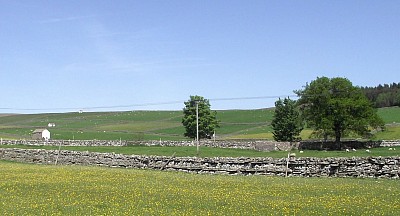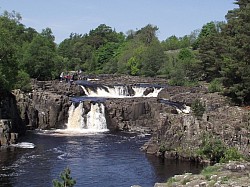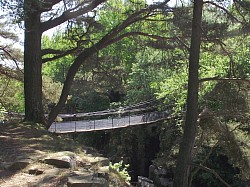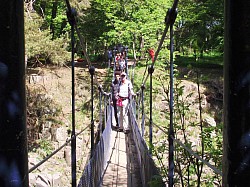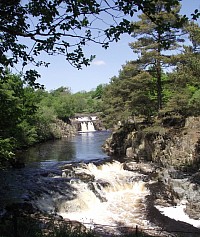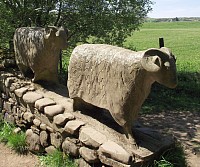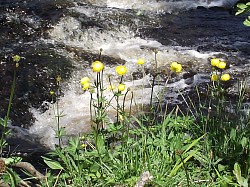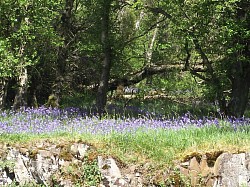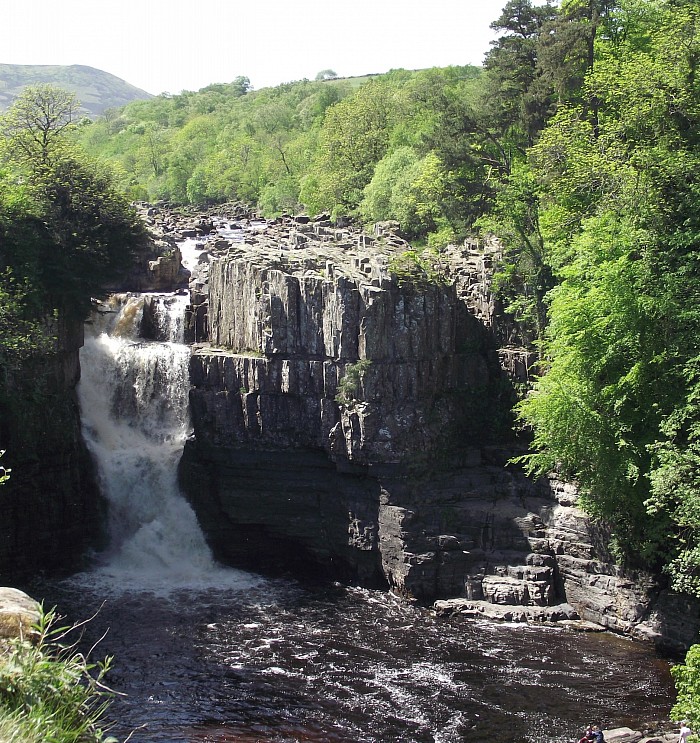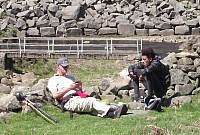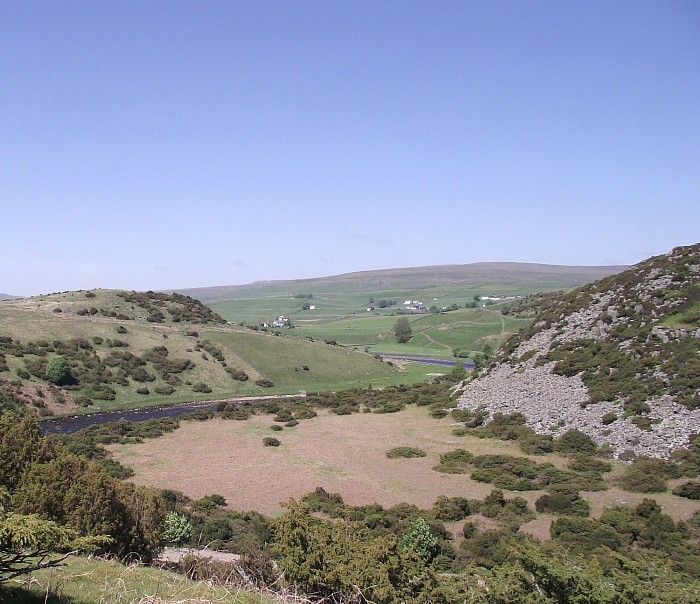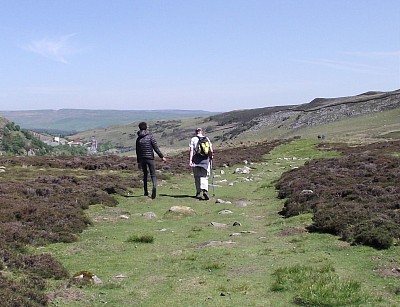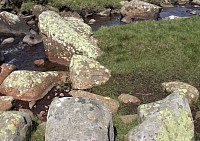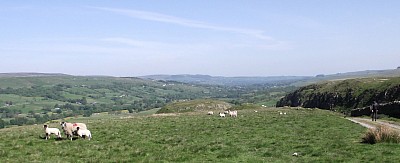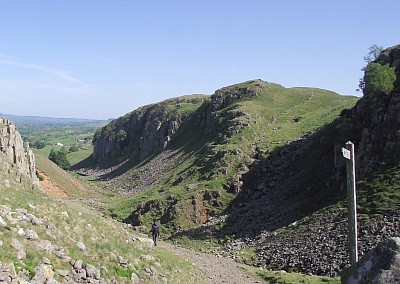Upper Teesdale
It has been a long winter, and a long time since we had a good walk, so we headed up Teesdale on a glorious sunny day at the end of May, not a cloud in the sky, and just enough breeze to make walking pleasant. The River Tees is the boundary between County Durham and Yorkshire, so our walk began in County Durham but soon crossed the river to God's Own County. We parked at Bowlees, and crossed the road to a footpath which went through this lovely buttercup meadow down to Low Force, a dramatic set of waterfalls crashing through narrow rocks. A very popular visitor attraction.
We crossed the Wynch bridge to the Yorkshire side of the River Tees, very busy indeed. The sunshine had brought lots of people out. The Wynch Bridge is supposed to have been the earliest suspension bridge in the country if not Europe. The first bridge across the river was recorded as early as 1704, built by lead miners crossing from the Yorkshire side to mines in County Durham. It spans a chasm 70 feet across and 60 feet deep. The first bridge was so named because a windlass or winch or wynch was used to lift chains across the river. It consisted of two chains 21 inches apart with wooden planks across and one hand rail. The links of the chains were six inches long and three quarters of an inch wide. Eventually the planks became rotten, and the bridge swung alarmingly, but still locals used it to cross until an accident in August 1820. A party of nine men and two women were crossing from Holwick in Yorkshire to County Durham when the bridge became unbalanced and one chain snapped, the whole thing turned upside down and the party were thrown off the bridge. Three men were flung into the water, one woman clung to the hand rail until rescued. Only one man drowned, John Bainbridge of Howgill near Bowlees. They had been helping Thomas Tallentyre of Holwick with his haymaking. The bridge was replaced in 1830, and happily we crossed without incident.
There are many distinctive breeds of sheep in the dales, Swaledales, Wensleydales, Mashams etc and also Teeswater sheep. The Teeswater has a distinctive long curly fleece, which is fine and lustrous and lovely to knit with. I can only assume that these sheep are of the local breed, they were not going far and guarding the footpath that took us upstream on the Yorkshire bank of the river.
All along the river bank the wild flowers were just glorious. The globe flower, trollius europaeus grows right on the edge of the river and is really stunning. Wood cranesbill geranium sylvaticum shone like jewels with crosswort, cruciata laevipes, cinquefoil, potentilla reptans, daisies, buttercups, wild parsley, all were a delight, and even this late in May hosts of heavenly bluebells made the walk just stunning . After a mile or two we walked through wild junipers, juniperus communis, where we had to dip our boots into some disinfectant to stop the spread of some disease which is fatal to wild junipers. These bushes, not so tall as to call them trees, are evidently a speciality of this part of Teesdale, and we walked through them for about another mile.
You hear it first, a rumble that gets louder, then the magnificent High Force comes into view. Mind you, you have to have a head for heights to be able to look down from the rocky viewing point. Water was coming down the left hand side, in times of flood it comes down the right hand side as well.
We walked just a little further up stream before stopping for a picnic next to this lovely waterfall. By now we had left the crowds far behind. Just us, wild flowers, juniper bushes, the waterfall - and - on the Durham side of the river a Huge Enormous Quarry !
Lunch doesn't look that interesting does it ! But we needed a sit and a rest. We soon left the River Tees and began a moderate ascent up Bracken Rigg where we were rewarded with a stunning view of Forest in Teesdale on the Durham side of the river. The reference to Forest does not mean that there is a lot of timber, in fact trees are scarce, but Forest in the meaning of a hunting ground where Forest Law would have been in force in Medieval times. This was the hunting ground for the Baliols. The farm houses are painted white. All the houses and buildings on the Raby Estate are white.
We then turned down a pasture and made our way onto a broad path to return back down the dale. You can see the quarry in the distance. All along this part of the walk there were nesting peewits, vanellus vanellus, I have always called them peewits because that is the sound they make, but they are also called lapwings or green plovers. They are ground nesting birds and if you get too close to the nest the parent birds try to distract you away by swooping round you. We heard, rather than saw, at least one pair of curlews as well, numenius arquata, another ground nesting bird. The sound of the curlew sums up early summer in the Yorkshire dales and I just love to hear them.
I am always interested in what I see around me, and although I have little pocket sized books on wild flowers, trees, butterflies, birds, I have never found a spotter's guide to lichens. These rocks had a distinctive bright lime green lichen on them, all the other rocks round about did not, so they really stood out. The photograph does not really show how bright they were. I would love to learn more.
After one more stop for food and a drink, we joined a stoned road used by shooters, crested the brow of a hill and this glorious view opened out in front of us. Now it was downhill all the way back to Holwick .
The last part of the walk brought us through some fantastic geology , towering cliffs called Holwick Scars left over from the last Ice Age. Holwick is a long narrow village and half way down the village street we climbed over a stile and descended through two pastures which were a carpet of buttercups and daisies. By now I was getting weary. We crossed Scoberry Bridge, a footbridge down stream from the Wynch Bridge, through another meadow of flowers, and up a lane back to Bowlees. A fantastic walk, seven and a half miles. Beautiful weather and Upper Teesdale was stunning.
It left me singing "Daisies are our silver/ Buttercups our gold/ This is all the treasure/ we can have or hold.
And what treasure it is.
